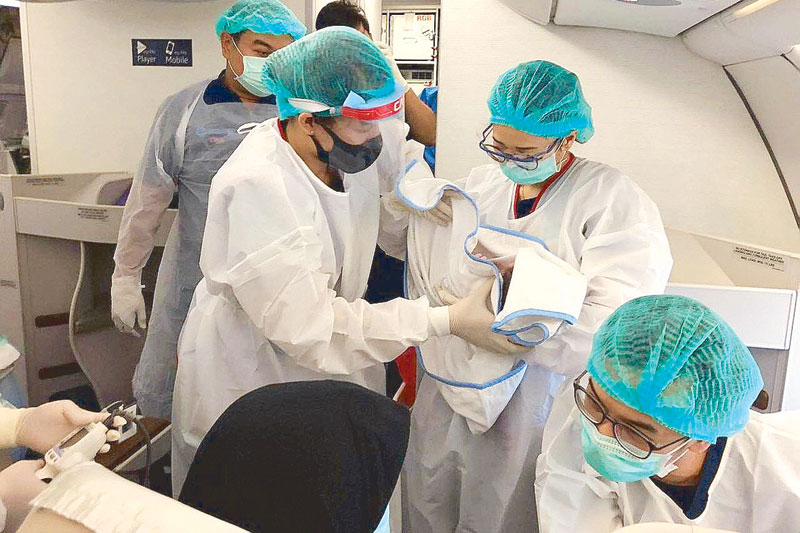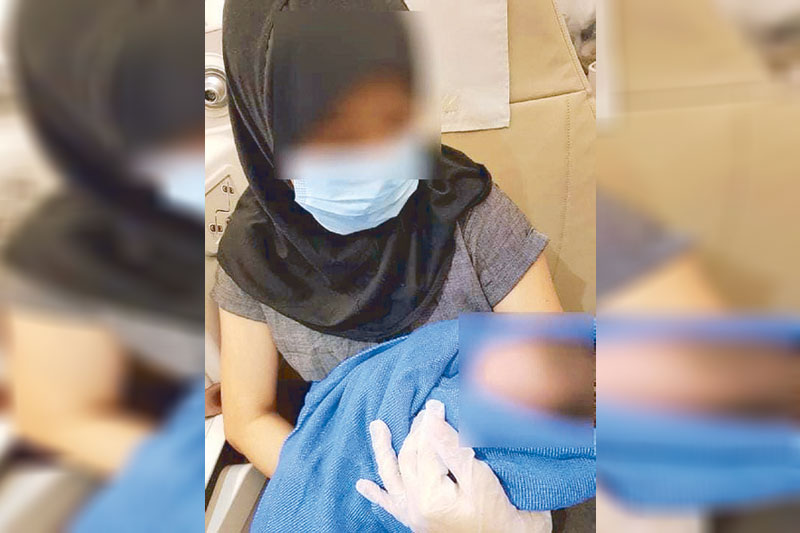by JOANNE RAE RAMIREZ
Every birth is a miracle, every birth has its risks, both to the mother and the baby. So what do you call a birth 30,000 feet up in the clouds, in the time of COVID-19 at that? A double miracle?
An assertion that life persists, life is stubborn, and that despite the hurdles and the hoops, life will find a way.
According to 2019 figures (“old normal” figures, if I may add) quoted by an article on Condé Nast Traveller, despite nearly 10 million flights that ferry over 3.5 billion passengers each year, it’s “very rare” for babies to be born on board.

“There are no official figures, but by some accounts, fewer than 60 babies have been born on aircraft.”
Fast forward to the “new normal,” the year the coronavirus has all but halted all commercial flights on the planet. And yet despite the rarity of flights came another rarity: a baby was born in mid-air, and both mother and baby are doing well.
“When you hear that many lives are lost to COVID-19 and you find out that there’s that miracle of life welcomed into the world above 30,000 feet, it makes us realize that there are still blessings… that abound,” says PAL spokesperson Cielo Villaluna. “The PAL crew is trained to deal with these inflight moments. An extraordinary situation. A celebration of a brand-new life, welcomed into this world above 30,000 feet.”
Flight PR 659 from Dubai to Manila departed Dubai International Airport at 8:55 p.m. local time on June 6, Saturday. Four hours into the flight, a female passenger started experiencing contractions; she was going into labor.
Giving birth on a plane is riskier, says obstetrician-gynecologist Rebecca Singson, whose own father was a PAL pilot, and who had a baby born in one of his flights!

“Having a baby born on an airplane is riskier, because it’s no different than delivering at home except you may not have all things necessary like a clamp and sterile scissors to cut the umbilical cord. But the first-aid kit of the planes should have them.”
When alerted that a passenger was experiencing labor pains, flight purser Daisy Castellano called on her team of cabin crew, three of whom were registered nurses.
The second officer of the flight called Med-Air, which linked him to an accredited medical doctor to provide guidance.
Purser Daisy recalls she did not panic when informed that a woman was in the throes of labor in mid-air because, though it was her first time to experience such a situation, “We were trained for this kind of scenario and other unusual inflight occurrences.”
“I was on my crew rest shift when the FA alerted me. I was silently praying the whole time and asking for guidance in handling the situation. I was also mentally reviewing the proper procedures we learned from training for this particular situation,” Daisy adds.
It was fortuitous that two members of the crew were nurses, namely, FA Joan Rivera and FA Maria Josefina Lobo.
“I was relieved when the baby seemed well and healthy as he was crying in my arms. It was a very humbling experience. I am grateful that I was able to lead a very capable team,” Daisy recalls, still suffused with joy.
The captain of the flight decided it would be best to divert to Bangkok for medical evaluation of mother and child. Medics were present to meet mother and baby as soon as the plane’s door was opened. Mother was given dextrose and placed on a wheelchair while newborn was held by a medic. They were brought to a hospital in Bangkok for checkup and have since been declared safe and sound.
“To aspiring flight attendants, know that the job carries many responsibilities. While working at high altitudes, you can be called to take the role of a nurse, a teacher, a firefighter and many more,” Daisy points out.
“But most of all, your major responsibility is ensuring the safety of the passengers.”
***

Cielo says “focus and teamwork,” plus “buong-pusong alaga” made the miracle at 30,000 feet a reality. “This was the winning formula that enabled the cabin crew team of a PAL Manila-bound flight from Dubai to successfully bring into this world a healthy baby boy.
“Thank you purser Leilani Daisy Castellano, FA Joan Rivera, FA Maria Josefina Lobo, FA Maria Cordis Carlyle Yuchongco, FA Marie Rose Coronel, FA Nancy Montinola, FS Dino Karganilla, FS Jose Madarang Jr., FS Ronniel James Mendoza and FS Warren Santiago. Thank you to the flight deck for their support, Capt. Mark Palomares, FO Herky Vitug and SO Fidel Guzman Ala. FO Ala secured further guidance from a medical doctor via SAT-phone and relayed the information to purser Daisy and team. Cheers to the flight and cabin crew of PR 659!”
The government organized the flight in coordination with PAL. Passengers paid for their tickets. It is still called a repatriation because the government facilitated the mounting of the flight, which enabled stranded kababayans to go home.
Before deplaning, the mother was placed in a wheelchair and the baby was carried by the medical team.
They have been declared healthy and are on their way to Manila as of June 10.
According to online sources, a baby born on an airplane may: have the same citizenship as one (or both) of its parents; has the right to claim citizenship in the country where the airline is registered and become a citizen of the country where the plane was flying at that time (air territory).
Whatever citizenship the baby finally acquires, a baby born on a plane, especially on an international flight, is truly a citizen of the world.
I wish this baby will fly high later in life, because simply by being born, he has shown that the desire to live can be tenacious, and the desire to assist in bringing life into this world — a calling, not just a duty.
This tiny bundle could be a symbol of hope for all of us.
This story first appeared on the Philippine STAR, for Joanne Rae Ramirez’s column in the Newsmakers section





